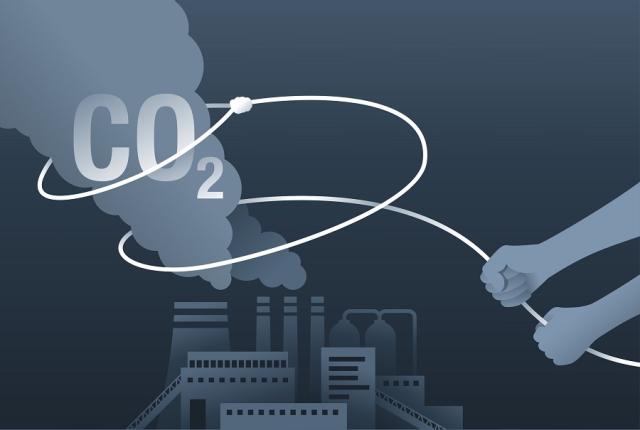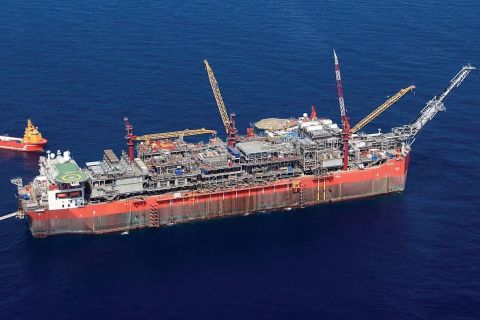
“All flags are green, but there’s a number of things that we need to look at as an industry that we need to tackle fully,” an SLB executive says. (Source: Shutterstock.com)
With targets set on reducing global CO2 emissions, the carbon capture and storage (CCS) sector is poised for takeoff; however, permitting, offtake agreements, financing and other risks are impacting its ability of CCS to scale, according to an SLB executive.
Gino Thielens, director of carbon storage for the SLB Carbon Solutions Group, highlighted challenges and solutions during a recent carbon capture and hydrogen technology conference in Houston.
“We need to realize that with the ramp-up today, the industry really has all the signs of being only in the very early stages of growth,” Thielens said. “What we see today is many different players from many different backgrounds—from oil and gas, some industrial gases, some from biofuels, etcetera.”
Partnerships are being created to complement skillsets that enable projects. But a main concern is putting all the pieces together to minimize risk.
CCS is seen as essential to reaching net-zero emissions ambitions by 2050. CO2 can be captured from high emitters such as power generators and industrial facilities that use fossil fuels and store it underground. Though the number of CCS projects has been increasing in recent years amid incentives, CCS is not on track, according to the International Energy Agency.
There were nearly 200 CCS projects in the facilities pipeline as of September 2022, up about 44% from about the same time a year earlier, according to the Global CCS Institute. Of those, 30 facilities were operational.
“From the 30-40 million tonnes per annum that’s currently being sequestered, we should scale up by the end of the next decade, probably at the end of this decade, to about half a gigaton per annum and then go to 2.5 gigatons the following decade,” Thielens added. “So that’s a significant ramp-up. That’s 25% year-on-year growth for the next 15 years.”
Challenges to scaling up
Incentives in the Inflation Reduction Act (IRA) are making the sector attractive. The IRA’s 45Q tax credit allows CCS players to claim $85 per metric ton of qualified carbon oxides captured and sequestered (up from $50) and $180 per metric ton for direct air capture projects.
Thielens also pointed to European and Canada licensing rounds for potential storage sites; and the introduction of carbon taxes on emissions in Australia, Canada and Europe that are incentivizing developers.
“We should see over the next five years a level of normalization kick in, where basically we start to see a more developed ecosystem of players within the industry [in which] people know each other's strengths much better. Where contractual structures start to become more well-defined,” he said.
Still, risks exist and several factors are holding back the scaling up of CCS.
“From a regulatory perspective, there’s a lot of incentives that have been put in place,” Thielens said. “But when we look at the permitting side, it is still problematic. For example, in the U.S., we see an enormous backlog building up of permit applications with very few permits being granted.”
For projects in which SLB has been involved, there is sometimes a misunderstanding between what the developer believes should be included in the permit application versus what the permitting agency wants to see, Thielens said, adding the volume of applications has also risen.
Data from the Environmental Protection Agency shows it has only granted permits for two Class VI wells—both for Archer Daniels Midland Co. in Illinois— out of about 90 applications submitted for projects in nine states.
Offtake arrangements are not risk-free. Thielens pointed out how a shutdown on the capture site would lead to a shutdown on the storage side.
Financing poses additional concerns, though CCS projects have attracted interest from investors. Surface construction risk is well understood by the finance industry; however, due diligence on the financiers’ side goes to another level when storage and geological risks concerning leakage rates and integrity enter the equation, Thielens added.
Other concerns involve public image, including site selection opposition; and risks involving potential exposure to capex overruns.
Finding ways to scale
Looking at storage site selection and key technologies such as geological evaluation, workflows are understood and technologies are mature, he said.
Yet, challenges could be on the horizon.
“When you start to inject CO2 at much larger quantities into a saline aquifer, the aquifer might not be able to accommodate all the incremental volume being put underground and you start to have pressure build up,” Thielens explained. “That pressure will need to be managed either by spreading out with multiple wells or drilling relief wells. So, from a design perspective, this becomes a major consideration when we start looking at developing hubs.”
Effectively using pore space and how effectively the space fills before pressure builds up become concerns that need to be managed properly.
Plus, there is still learning to be done on CO2’s behavior relating to geochemistry, mineralization downhole and the impact on injectivity.
“What we’re trying to do here is basically build digital tools to accelerate the whole maturation process,” Thielens said. “At the moment, we’re focusing predominantly [on] on-site screening and detailed characterization. We’ve just released a site screening tool that basically helps to quickly identify the viability of potential storage sites at the first pass,” replacing much of the subjective interpretation with arithmetic evaluation and ranking.
To address injection performance with focus on plume management and integrity, a risk-based measurement, monitoring and verification system is used. The goal is to find the best combination of technologies. Attention is on identifying well integrity problems, including potential reactivation of a fault or a leak to a shallower zone.
“Obviously, we need to understand very clearly how the plume is developing downhole and whether it behaves as we modeled in the reservoir models,” he said.
Pore space optimization is also examined, given economics and infrastructure needs.
Having a skilled workforce is also key, Thielens added, as competency development programs reskill existing engineers while attracting graduate engineers.
“The time is now. All flags are green, but there’s a number of things that we need to look at as an industry that we need to tackle fully.”
Recommended Reading
TotalEnergies Starts Production at Akpo West Offshore Nigeria
2024-02-07 - Subsea tieback expected to add 14,000 bbl/d of condensate by mid-year, and up to 4 MMcm/d of gas by 2028.
Well Logging Could Get a Makeover
2024-02-27 - Aramco’s KASHF robot, expected to deploy in 2025, will be able to operate in both vertical and horizontal segments of wellbores.
Shell Brings Deepwater Rydberg Subsea Tieback Onstream
2024-02-23 - The two-well Gulf of Mexico development will send 16,000 boe/d at peak rates to the Appomattox production semisubmersible.
E&P Highlights: Feb. 26, 2024
2024-02-26 - Here’s a roundup of the latest E&P headlines, including interest in some projects changing hands and new contract awards.
Remotely Controlled Well Completion Carried Out at SNEPCo’s Bonga Field
2024-02-27 - Optime Subsea, which supplied the operation’s remotely operated controls system, says its technology reduces equipment from transportation lists and reduces operation time.






